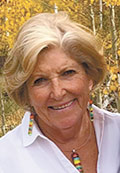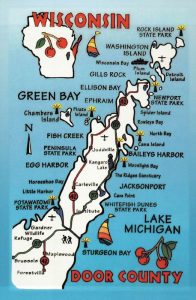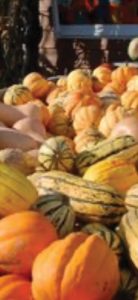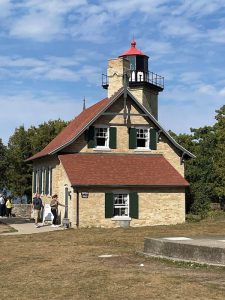November 1, 2024
The Cape Cod of the Midwest, Part 1
 By Mary Schricker Gemberling
By Mary Schricker Gemberling
“It’s the first day of autumn! A time of hot chocolatey
mornings and tasty marshmallow evenings,
and best of all leaping into leaves!…….Winnie the Pooh
Those of you who follow my articles know that every fall since we met, Gary and I take a leaf peeping trip in search of the vibrant autumn colors. In past years we have traveled in all directions to Michigan, Colorado, Southern Illinois, the East Coast, Missouri, Iowa and the Finger Lakes in New York. Four years ago we were joined on these RV trips by Gary’s college friends, Barb and Jerry Neumann. This June we received sad news that Barb Neumann has died of congestive heart failure. Her husband was reticent to join us this year, but at the urging of his daughter decided he would come. We had already decided at the close of last year’s trip that our 2024 destination would be Door County, Wisconsin, a popular fall destination that is often referred to as ‘The Cape Cod of the Midwest.’
 In late summer we firmed up our plans to meet at the Wagon Trail campground at the far northern part of Door County on September 29th. This particular campground is a favorite one with the remote sites nestled among the trees. We arrived within fifteen minutes of each other, unhitched the truck and set up at our respective sites. We would be staying for three nights and then moving south to Bailey’s Grove campground for the last two nights of our trip. Feeling hungry after our long drive, we drove to the nearby town of Ellison Bay in search of dinner. We decided on Mink River Basin, a down to earth, family-run sports bar and grill. The reviews were spot on as I had one of the best burgers I have eaten in a very long time. During dinner we discussed a preliminary plan for the next few days.
In late summer we firmed up our plans to meet at the Wagon Trail campground at the far northern part of Door County on September 29th. This particular campground is a favorite one with the remote sites nestled among the trees. We arrived within fifteen minutes of each other, unhitched the truck and set up at our respective sites. We would be staying for three nights and then moving south to Bailey’s Grove campground for the last two nights of our trip. Feeling hungry after our long drive, we drove to the nearby town of Ellison Bay in search of dinner. We decided on Mink River Basin, a down to earth, family-run sports bar and grill. The reviews were spot on as I had one of the best burgers I have eaten in a very long time. During dinner we discussed a preliminary plan for the next few days.
First on our week’s agenda was to take the Ferry to Washington Island, located about seven miles northeast of Door County. Covering approximately 35 square miles and home to 710 people, it is the largest of six islands, including Detroit, Rock, Plum, Pilot and Hog. Early records indicate that both the Indians and French were early visitors to these islands. The Potawatomi appear to have come to the islands in about 1641. In the late 17th century, French explorer and fur trader Robert La Salle did a flourishing business with the Indians. But on September 18, 1679 La Salle departed the island with a load of furs and was never heard from again. Subsequently the narrow passage to the island became known as ‘Death’s Door,’ a name that is often used today to spark the curiosity of tourists traveling to the island. In 1870 W.F. Wickman, a Dane persuaded four bachelors from Iceland to move to Washington Island. They came and established the second oldest Icelandic settlement in America. Early settlers were primarily fisherman, but other new arrivals from Norway, Sweden, and Denmark brought farming, and logging to the island. The Island exports included fish, lumber, stone, potatoes and maple syrup. A popular retreat for the late 19th and 20th century visitors looking to escape their urban stresses, the island grew to be a tourist destination for many families whose descendants still call Washington island their summer home. After spending the entire day exploring the island’s parks, historical landmarks, and shops we understood why so many families had continued to spend their summer’s there. Before departing on an afternoon Ferry back to the mainland we enjoyed another great meal at the Nelson’s Hall, Bitters Pub and Restaurant.
 During the next couple of days we explored the 300 miles of Great Lakes shoreline from Gill’s Rock to Sturgeon Bay and back up the other side returning to Rowley’s Bay. The communities have been likened to a string of pearls, running up and down the peninsula, tying them all together. If I tried to describe every place we stopped to visit this article would fill the entire magazine, so I will try to highlight a few of my favorites.
During the next couple of days we explored the 300 miles of Great Lakes shoreline from Gill’s Rock to Sturgeon Bay and back up the other side returning to Rowley’s Bay. The communities have been likened to a string of pearls, running up and down the peninsula, tying them all together. If I tried to describe every place we stopped to visit this article would fill the entire magazine, so I will try to highlight a few of my favorites.
I am by nature a farmer’s market junkie so I have to begin with my affinity to the many farm stands dotting the landscape of Door County. Buying local isn’t just a catch phrase here, it’s a way of life. Seasonally there are eight different farmer’s markets that set up different days of the week throughout the peninsula where vendors sell their local homegrown goods and crafts. But the permanent farm stands are my favorite to visit. The colorful pumpkins and mums make them easy to spot while driving from town to town. We stopped at as many stands as my patient husband was willing to endure. Of course the possibility of fresh baked goods for sale inside did entice him. Although we never found any cinnamon rolls, we were able to buy fresh picked apples, cherry jam, and fresh baked cherry pie.
Door County is home to 11 lighthouses still standing tall above the shores of the peninsula. Most were built in the 1800’s, landmarks of yesteryear that assisted the sailors navigating the lake and bay waters of the Door County peninsula and surrounding islands. They saved countless lives, and some continue today to help boats find their way to port. We drove by and visited several, impressed by the unique architecture of each one.
 Door County’s most valuable asset is its natural beauty. Home to five state parks and twenty county park, the area is a haven for those who like to explore, hike, fish, bike, boat or camp. Since this was a leaf peeping adventure for us we ooh-ed and aah-ed our way through many of the parks stopping to absorb the beauty and history unique to the area. There are few things as relaxing as slowly meandering through these country roads just taking in the surrounding beauty.
Door County’s most valuable asset is its natural beauty. Home to five state parks and twenty county park, the area is a haven for those who like to explore, hike, fish, bike, boat or camp. Since this was a leaf peeping adventure for us we ooh-ed and aah-ed our way through many of the parks stopping to absorb the beauty and history unique to the area. There are few things as relaxing as slowly meandering through these country roads just taking in the surrounding beauty.
The Upper Midwest is home to a large number of Swedish descendants and Door County is no exception. Scandinavian architecture, traditions, and customs are present across the county especially evident in the shops and dining menus. Al Johnson’s Swedish Restaurant is one such establishment. This isn’t our first time dining at the restaurant but this time we wanted to try their Swedish pancakes. My plate full of thin pancakes topped with Lingonberries did not disappoint. Al Johnson and his wife started the restaurant in 1949. The menu consists of a variety of authentic Swedish dishes served by men and women in traditional Scandinavian clothing. In 1973 the restaurant was remodeled to add a Batik, (a Scandinavian gift shop) and a sod roof. A friend of Al Johnson placed a goat named Oscar on the roof as a joke, and thus spurred the idea of incorporating goats as a novelty. The idea is now trademarked, making it the only establishment in the United States with goats on the roof.
Another Scandinavian tradition that has fascinated visitors for more than 50 years in Door County is the Fish Boil. Though Native American settlers practiced their own version of the fish boil, the present one is rooted in the 1800’s when a large influx of Scandinavian immigrants brought the Nordic version to the area. With a seemingly endless supply of whitefish in Lake Michigan, the fish boil was an efficient and economical way to feed large crews of lumbermen who were busy clearing the native forests. For years the tradition was passed down through churches and family gatherings, but didn’t become a staple for visitors until 1961, when Lawrence and Annette Wickman began the fish boils at the Viking in Ellison Bay and the White Gull Inn in Fish Creek.In addition to the delicious meal, it is the experience that draws visitors year and year. Locally caught whitefish are boiled in a large kettle, under the supervision of a Boil master, over an open fire in an outdoor community-style kitchen. Prior to eating, guests are seated on benches to witness both the explanation and cooking process of the meal. When seated in the dining room diners are served mild whitefish, potatoes, and onions with melted butter, bread, and Door County Cherry Pie. Many restaurants in the area now have fish boils. We tried the one at the Post Office restaurant in Ephraim. The Fish Boil is one adventure Door County visitors must experience!
Although we have only visited Door County in the autumn the tourism literature advertises many other activities that can be enjoyed year round. Each season brings its own variety of experiences. Spring is beautiful when the cherry blossoms are in full bloom. Door County summers are second to none with the bright sun, lake breeze, and outdoor music and festivals. Door County’s quiet winters are famous for holiday season festivities to polar plunges, and winter festivals. Snowmobilers love the area when the trails are groomed and fireplaces are burning. The basis of many of Door County’s activities is a rich European culture. There is a nordic term, Hygge (pronounced ‘Hoo-guh’) that refers to the coziness and comfort that is prioritized in the Scandinavian countries. The concept centers around the peacefulness and wellbeing that can be garnered by embracing little, special moments, sitting by the fire, gathering with friends and family or snuggling up under a blanket with a book. Hygge can be practiced year-round, but it’s especially fitting in wintertime, when the days are short and the weather is cold, because in the Scandinavian culture, all seasons are to be embraced. This feeling of nostalgia is pervasive throughout Door County. Visiting there is a bit like being in a simpler, calmer time of our past.
From sunrise to sunset we seemed to stay busy during every day of our visit. We enjoyed a fair amount of retail therapy in the many boutiques available throughout Door County. We also tried other restaurants and can’t remember ever being disappointed in either the food or atmosphere. As you can imagine at the end of each busy day we were ready for some relaxation back at the campground. We ended each evening with a game or two of Euchre and a conversation at the campfire. As we prepared to leave on Friday morning we all agreed that it had been another great week celebrating autumn in all its splendor. Although we didn’t decide on next fall’s destination we are all hoping to meet again. At this stage of life there is a delicate balance between living each day to its fullest and long term planning!
“Another Fall, another turned leaf”……..Wallace Stegner
Tune in for Part 2 in our December edition.
Mary, a former educator and Seniors Real Estate Specialist is the author of four books: The West End Kid, Labor of Love; My Personal Journey through the World of Caregiving, Hotel Blackhawk; A Century of Elegance, and Ebenezer United Methodist Church; 150 Years of Resiliency.
Filed Under: Featured, Health & Wellness, History, News
Trackback URL: https://www.50pluslife.com/2024/11/01/the-cape-cod-of-the-midwest-part-1/trackback/


